七年级上册英语预备单元教案
- 格式:docx
- 大小:283.37 KB
- 文档页数:20
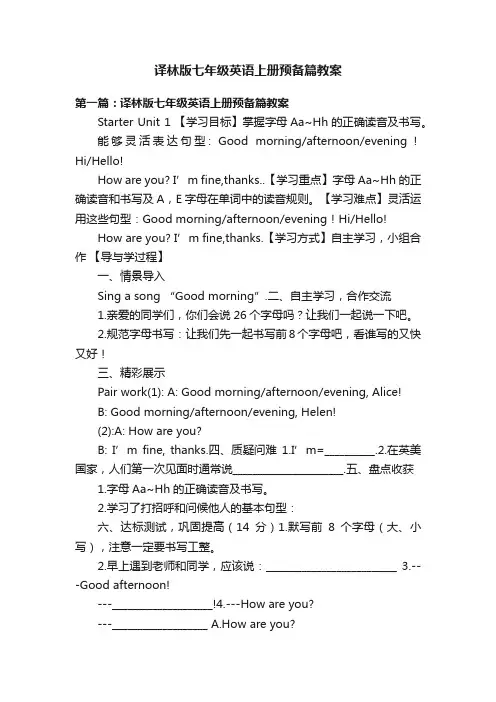
译林版七年级英语上册预备篇教案第一篇:译林版七年级英语上册预备篇教案Starter Unit 1 【学习目标】掌握字母Aa~Hh的正确读音及书写。
能够灵活表达句型: Good morning/afternoon/evening!Hi/Hello!How are you? I’m fine,thanks..【学习重点】字母Aa~Hh的正确读音和书写及A,E字母在单词中的读音规则。
【学习难点】灵活运用这些句型:Good morning/afternoon/evening!Hi/Hello!How are you? I’m fine,thanks.【学习方式】自主学习,小组合作【导与学过程】一、情景导入Sing a song “Good morning”.二、自主学习,合作交流1.亲爱的同学们,你们会说26个字母吗?让我们一起说一下吧。
2.规范字母书写:让我们先一起书写前8个字母吧,看谁写的又快又好!三、精彩展示Pair work(1): A: Good morning/afternoon/evening, Alice!B: Good morning/afternoon/evening, Helen!(2):A: How are you?B: I’m fine, thanks.四、质疑问难1.I’m=__________.2.在英美国家,人们第一次见面时通常说______________________.五、盘点收获1.字母Aa~Hh的正确读音及书写。
2.学习了打招呼和问候他人的基本句型:六、达标测试,巩固提高(14分)1.默写前8个字母(大、小写),注意一定要书写工整。
2.早上遇到老师和同学,应该说:__________________________3.---Good afternoon!---____________________!4.---How are you?---___________________ A.How are you?B.Fine, thank you.C.Good morning!5.字母的含义:HB _____________ CD__________BBC_______________七、作业布置阅读下节教材,提出你发现的有价值或困惑的问题,填写在下节“师生随笔”中;八、自我反思Starter Unit2 【学习目标】掌握字母I~R的正确读音及书写;学会句型“What’s this/that in English?” 【学习重点】字母I~R的正确读音及书写;E、O的读音规则。

新目标英语七年级上册教案(2017---2018第一学期)Starter Unit 1 Good morning!一、单元教材分析本单元要求学生掌握英文字母A—H,能认读其印刷体和手写体字母的大小写等四种形式。
书写(大写和小写,笔顺,笔画)基本合乎要求。
学习一些简单的英文名字,注意区别性别,并为自己取一个英文名字。
能看、听、说、唱本单元所列的日常交际用语,重点学会打招呼、相互问候并做到语音语调正确。
注意一些字母及日常交际用语的发音,总结元音字母a和e的发音规则。
二、单元学情分析本单元围绕“问候他人”这一话题,展开听、说、读、写的教学活动。
为了创设较为真实的语言环境,首先让学生们认识一些较为简单的英文名字,并让学生们为自己取一个英文名字,让学生们感知、认识英语,并尽快进入英语的环境中。
在教学过程中应让学生体会打招呼用语的奥妙所在,做到灵活运用。
刚开始学习英语,学生们肯定对学习英语的兴趣非常深厚,教师一定要利用好这一点,让学生在学习英语中能获得乐趣。
并逐步让学生们形成稳定的学习兴趣。
三、单元教学建议采用自主学习、小组合作学习、Role playing、pair work等方式开展听、说、读、写的学习活动。
教师要尽量利用幻灯片、挂图、实物等给学生创造较为真实的英语情景。
在教学中创设切实可行的任务型教学活动、突出交际性。
引趣激趣策略,创设情景调节气氛,引发激发学生兴趣。
教师可以用手势,表情,动作等示意,帮助学生听懂课堂用语和日常交际用语,不讲或少讲汉语。
四、单元课时分配:本单元可用3课时完成教学任务:(1a-2e) 用1课时(3a-4d) 用1课时Revision 用1 课时Starter Unit 1 Good Morning!The first period 【Section A 1a-2e】Teaching Aim and Demands:1. 语言知识目标:1) 能掌握以下词汇:字母Aa ~ Hh, good, morning, Good morning!, hi, hello2) 能掌握以下句型:①Good morning, Helen! ②Hello, Frank! ③Hi, Bob!3) 能理解用英语打招呼的不同说法,并能灵活运用。
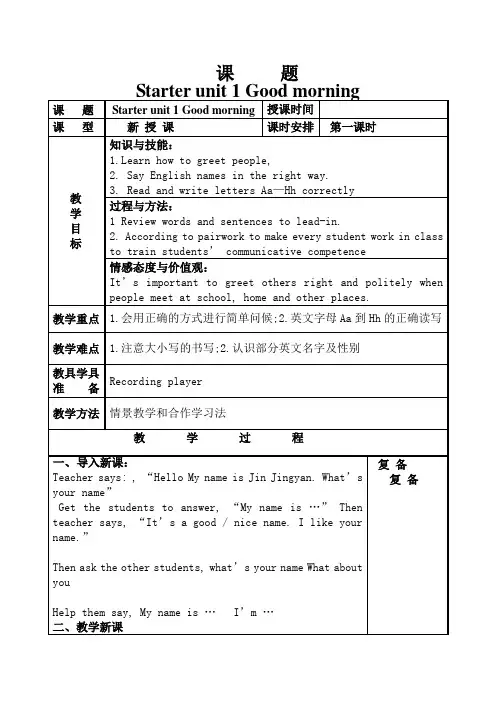
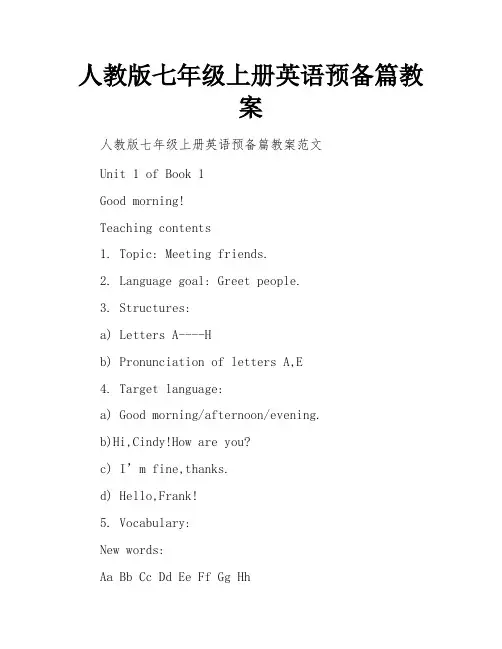
人教版七年级上册英语预备篇教案人教版七年级上册英语预备篇教案范文Unit 1 of Book 1Good morning!Teaching contents1. Topic: Meeting friends.2. Language goal: Greet people.3. Structures:a) Letters A----Hb) Pronunciation of letters A,E4. Target language:a) Good morning/afternoon/evening.b)Hi,Cindy!How are you?c) I’m fine,thanks.d) Hello,Frank!5. Vocabulary:New words:Aa Bb Cc Dd Ee Ff Gg Hhhi hello good morning afternoon evening fine thanksPhrases:Good morning/afternoon/evening. How are you? Thanks.=Thank you. I’m=I amTeaching aims1. Knowledge objects :a) Structuresb) Target languagec) New words and expressionsd) The conversation2. Ability objects :Get the students be able to greet people each other.3. Moral objects :Make the students be interested in English. Learning strategies1. Listening for key words2. Using what you know OKConscious of the Culture Make the students to know how to greet people in everyday life. Teaching keys1. Greet people2. Target language3. New words and expressions4. Letters A----HTeaching difficulties1. Pronunciation of letters A,E2. How to greet peopleActivity planned1. Pairwork2. Groupwork3. Role play4. ListeningTeaching aids1. Cards2. tape-recorderTeaching time4 periods(section A + section B + Selfcheck)【摘要】随着“微时代”的来临,各种“微”元素对我们的生活和工作产生了巨大的影响,在我们的教育领域,“微课”也正在掀起一场革命。
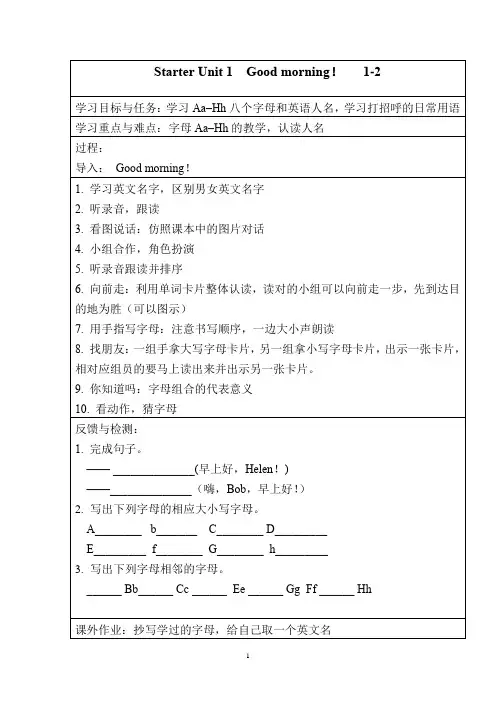
A:How2you?B:Fine,3.4are you?A:I'm5.三、将下列名字分类。
A.Dale B.Helen C.Eric D.Alice E.GraceBoys’name (男孩名)_________________________________[来源:学。
科。
网Z。
X。
X。
K]Girls’name(女孩名)_________________________________四、选择题。
()1. 现在是下午2点,如果你见到朋友时,应该怎么说__________A.Good morning!B. Hi!C.Good afternoon!D.I'm fine.()2.你出席一个晚会,应该怎样与别人打招呼?A.How are you?B.I'm Kim.C.Good evening.D.Good morning.()3.下午你见到老师时,你应该说:“__________.”A.Good afternoon,teacherB.Good morning,teacherC.TeacherD.Good evening,teacher()4. ------ __________________------ I’m OK,thanks.A.Good morning.B.How are you?C.Hello! Nice to meet you. D. Hi()5. 在英语中单个字母代表一个单词的是_________。
A.d B.h C.I D.gStarter Unit 2 What’s this in English?1a-3a【学习目标】1. 复习巩固字母Aa—Hh2. 复习打招呼的用语、朋友见面的问候语和应答。
3. 七个表示物体的单词的熟练掌握。
4. 确认物体的句型:What is this in English?【重点、难点】1. 七个表示物体的单词map、ruler、pen、orange、key、jacket、quilt 的熟练掌握。
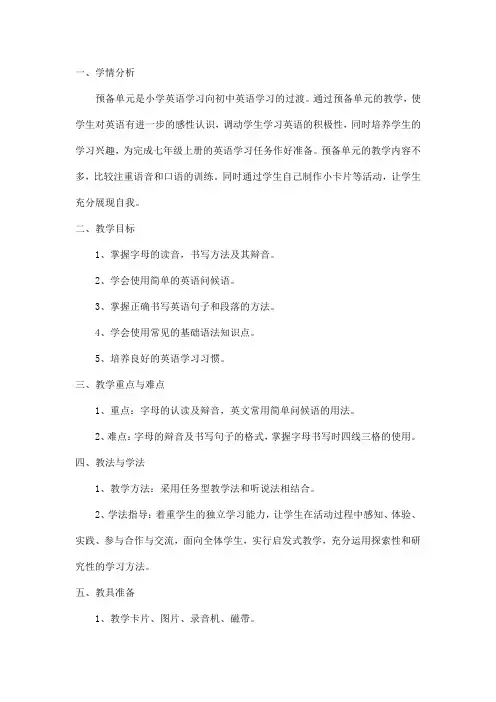
一、学情分析预备单元是小学英语学习向初中英语学习的过渡。
通过预备单元的教学,使学生对英语有进一步的感性认识,调动学生学习英语的积极性,同时培养学生的学习兴趣,为完成七年级上册的英语学习任务作好准备。
预备单元的教学内容不多,比较注重语音和口语的训练。
同时通过学生自己制作小卡片等活动,让学生充分展现自我。
二、教学目标1、掌握字母的读音,书写方法及其辩音。
2、学会使用简单的英语问候语。
3、掌握正确书写英语句子和段落的方法。
4、学会使用常见的基础语法知识点。
5、培养良好的英语学习习惯。
三、教学重点与难点1、重点:字母的认读及辩音,英文常用简单问候语的用法。
2、难点:字母的辩音及书写句子的格式,掌握字母书写时四线三格的使用。
四、教法与学法1、教学方法:采用任务型教学法和听说法相结合。
2、学法指导:着重学生的独立学习能力,让学生在活动过程中感知、体验、实践、参与合作与交流,面向全体学生,实行启发式教学,充分运用探索性和研究性的学习方法。
五、教具准备1、教学卡片、图片、录音机、磁带。
2、生词卡片及小黑板。
3、教学挂图。
4、相关游戏活动所需的道具。
六、教学进度安排(共2课时)第1课时:Unit 1—Unit 2(听说训练)第2课时:Unit 3—Unit 4(听说训练)七、评价与反馈1、课堂评价:教师随时对学生的学习进行评价,用鼓励性的语言进行表扬和批评,并指出不足之处,提出改进要求,创设情景或根据学生存在的问题给予个别辅导,让学生进一步掌握本节课所学内容。
2、学生自我评价:学生通过自我评价来了解自己的进步和不足,以便更好地改进自己的英语学习。
在预备单元结束时,让学生对自己的学习情况进行自我评价,然后教师给予适当的指导,帮助学生树立学好英语的信心。
3、作业反馈:教师及时批改学生的作业,了解学生的学习情况,并记录下来作为学生的学习档案。
对于普遍存在的问题进行集体辅导,个别性的问题则进行单独辅导。
让学生在原有问题上有所提高。
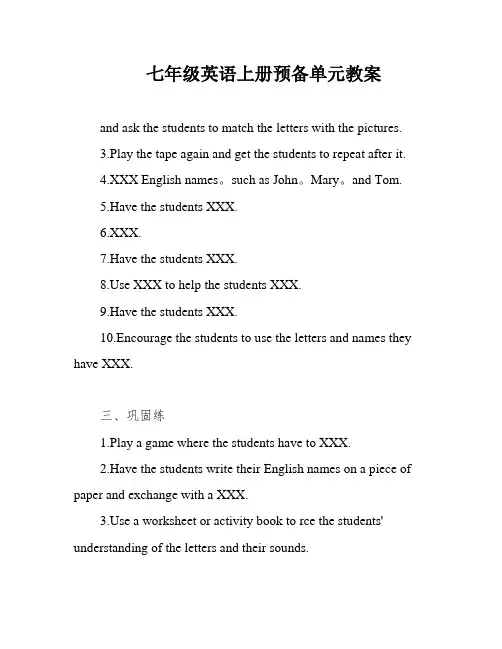
七年级英语上册预备单元教案and ask the students to match the letters with the pictures.3.Play the tape again and get the students to repeat after it.4.XXX English names。
such as John。
Mary。
and Tom.5.Have the students XXX.6.XXX.7.Have the students XXX.e XXX to help the students XXX.9.Have the students XXX.10.Encourage the students to use the letters and names they have XXX.三、巩固练1.Play a game where the students have to XXX.2.Have the students write their English names on a piece of paper and exchange with a XXX.e a worksheet or activity book to rce the students' understanding of the letters and their sounds.4.Have the students practice greeting each other using the English phrases they have learned.四、作业布置1.Assign XXX Aa to Hh and their English names.2.Encourage the students to practice greeting their family and friends using the English phrases they have learned.本课结束,研究好资料欢迎下载。
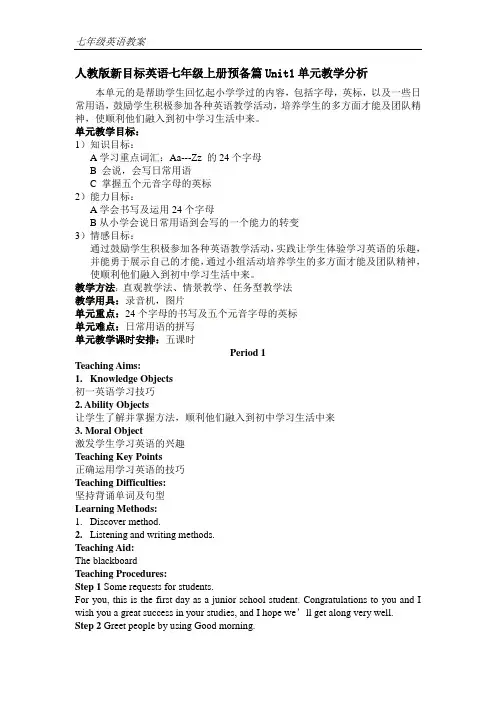
人教版新目标英语七年级上册预备篇Unit1单元教学分析本单元的是帮助学生回忆起小学学过的内容,包括字母,英标,以及一些日常用语,鼓励学生积极参加各种英语教学活动,培养学生的多方面才能及团队精神,使顺利他们融入到初中学习生活中来。
单元教学目标:1)知识目标:A学习重点词汇:Aa---Zz 的24个字母B 会说,会写日常用语C 掌握五个元音字母的英标2)能力目标:A学会书写及运用24个字母B从小学会说日常用语到会写的一个能力的转变3)情感目标:通过鼓励学生积极参加各种英语教学活动,实践让学生体验学习英语的乐趣,并能勇于展示自己的才能,通过小组活动培养学生的多方面才能及团队精神,使顺利他们融入到初中学习生活中来。
教学方法:直观教学法、情景教学、任务型教学法教学用具:录音机,图片单元重点:24个字母的书写及五个元音字母的英标单元难点:日常用语的拼写单元教学课时安排:五课时Period 1Teaching Aims:1.Knowledge Objects初一英语学习技巧2. Ability Objects让学生了解并掌握方法,顺利他们融入到初中学习生活中来3. Moral Object激发学生学习英语的兴趣Teaching Key Points正确运用学习英语的技巧Teaching Difficulties:坚持背诵单词及句型Learning Methods:1.Discover method.2.Listening and writing methods.Teaching Aid:The blackboardTeaching Procedures:Step 1 Some requests for students.For you, this is the first day as a junior school student. Congratulations to you and I wish you a great success in your studies, and I hope we’ll get along very well.Step 2 Greet people by using Good morning.Step 3 Pair workAsk students to discuss how to learn English well.Step 4 T each them the right way.初一学的英语都是为将来打基础的,只有在下层建筑打好的情况下,上层建筑才能建好。

Starter Unit 1 Good morning!一、教材剖析预备篇的主要内容为26 个字母和最基本的英语平常用语。
教材的编写主假如帮助那些没有英语基础的学生更好地使用本套教材,同时又帮助有一点基础的学生赶快熟习教材中的人物,激发他们的自信心,加强说英语的兴趣。
本单元的教课内容为:1.学习 Aa --- Hh 八个字母。
2.学习八个人名。
Alice, Bob, Cindy, Dale, Eric, Frank, Grace, Helen3.学习打招呼的用语:Hello!/ Good morning!/ Good afternoon!/ Good evening!4.学会问候熟习的朋友和应答:--How are you?--I ’ m fine, thanks. How are you?--I ’ m OK二、教课方案思路本教材主假如依据学生的认知特色和学生的实质水平来编写的,不单帮助学生学会一些语言基础知识,更重要的是培育和发展学生的语言运用能力。
每个单元都环绕一此中心话题来设计不一样的任务,让学生经过“ Learn by doing. Learn by using. ”来达成。
对教师来说,有更大的自由度来灵巧运用教材,为自己的学生来量身定做学习方案。
本单元是为初学者准备的入门单元,整体内容不多,也不是很难,重点是做好一个连接工作,依据学生的认知特色和心理特色,经过多样化的、兴趣性的学习活动,让没基础的同学战胜内心的畏难情绪,感觉到英语不难又很风趣;让有基础的同学更进一步培育起对英语学习的兴趣和自信。
三、教课重点1.认识教材中的人物,熟习八个名字。
2.字母 Aa --- Hh 的教课。
3.打招呼的用语: Hello! Good morning. Good afternoon. Good evening.-- How are you?-- I ’ m fine, thanks. How are you? -- I ’ m OK.4. 字母 a, e 在开音节和闭音节中的读音规则。
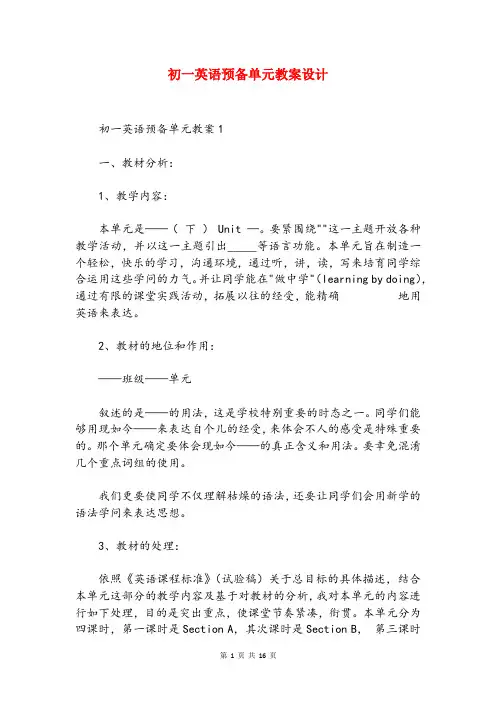
初一英语预备单元教案设计初一英语预备单元教案1一、教材分析:1、教学内容:本单元是——(下) Unit —。
要紧围绕""这一主题开放各种教学活动,并以这一主题引出_____等语言功能。
本单元旨在制造一个轻松,快乐的学习,沟通环境,通过听,讲,读,写来培育同学综合运用这些学问的力气。
并让同学能在"做中学"(learning by doing),通过有限的课堂实践活动,拓展以往的经受,能精确地用英语来表达。
2、教材的地位和作用:——班级——单元叙述的是——的用法,这是学校特别重要的时态之一。
同学们能够用现如今——来表达自个儿的经受,来体会不人的感受是特殊重要的。
那个单元确定要体会现如今——的真正含义和用法。
要幸免混淆几个重点词组的使用。
我们更要使同学不仅理解枯燥的语法,还要让同学们会用新学的语法学问来表达思想。
3、教材的处理:依照《英语课程标准》(试验稿)关于总目标的具体描述,结合本单元这部分的教学内容及基于对教材的分析,我对本单元的内容进行如下处理,目的是突出重点,使课堂节奏紧凑,衔贯。
本单元分为四课时,第一课时是Section A,其次课时是Section B,第三课时是Self Check,第四课时是——,后来一部分是做练习,以同学的自测为主,接着予以校对。
二、学情分析:我们教学的对象是初二同学(好,中,差等生都有),他们学习英语既感到惊奇又担忧,希望能得到他人的确信。
因此我在教学活动中尽可能让他们参与到活动中来,有更多的机遇来讲英语,削减他们的恐惊感,通过同学间的合作学习,落低他们的学习难度,使他们体验到成功的喜悦。
同时在阅读和书面表达中加以落实,提高他们综合运用语言的力气,使各层次的同学都有所收获。
三、教学目标:依照以上我对本单元教材内容的分析和新课标的指导,我确定以下几个为本单元的教学目标:语言学问,语言技能,学习策略,情感态度和文化意识五个方面。
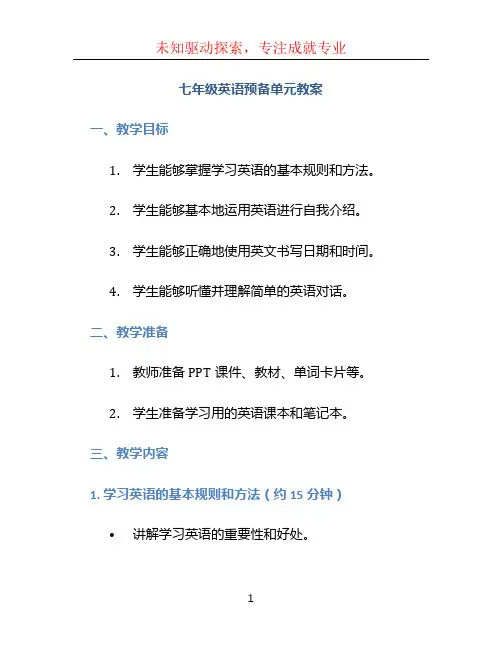
七年级英语预备单元教案一、教学目标1.学生能够掌握学习英语的基本规则和方法。
2.学生能够基本地运用英语进行自我介绍。
3.学生能够正确地使用英文书写日期和时间。
4.学生能够听懂并理解简单的英语对话。
二、教学准备1.教师准备PPT课件、教材、单词卡片等。
2.学生准备学习用的英语课本和笔记本。
三、教学内容1. 学习英语的基本规则和方法(约15分钟)•讲解学习英语的重要性和好处。
•介绍英语学习的基本规则和方法,如多听多说、多读多写等。
•给学生提供一些实践英语的方法,并鼓励他们积极参与课堂练习。
2. 自我介绍(约20分钟)•教师用PPT展示一份简单的自我介绍范例,并逐步解释其中的句子和词汇。
•教师为学生提供一些常用的自我介绍句型,并鼓励学生进行模仿和创作。
•学生根据学习的内容,自主编写一段简单的自我介绍,并进行小组互相交流。
3. 日期和时间(约20分钟)•介绍如何用英文表达日期和时间的基本规则。
•通过PPT展示日期和时间的表达方式,并做简单的练习。
•学生进行小组活动,利用所学进行日期和时间的交流。
4. 听力训练(约30分钟)•播放一段简短的英语对话,要求学生用听觉接收信息,并尽量理解对话内容。
•教师逐句播放录音,引导学生根据录音内容填写相关信息。
•学生进行小组讨论,互相核对答案,并与全班分享讨论。
四、课堂练习1. 练习1:完成自我介绍(约10分钟)指导学生根据所学内容,完成一篇自我介绍,并逐个抽查几位学生进行口头展示。
2. 练习2:书写日期和时间(约15分钟)教师给出一些日期和时间的写作练习题,要求学生用英文写出对应的日期和时间,并互相交流核对答案。
3. 练习3:听力理解(约20分钟)播放一段简短的英语对话,要求学生用听觉接收信息,并回答相关问题。
学生可以自主与同桌讨论答案。
五、作业布置布置以下作业,鼓励学生积极参与,培养英语学习的兴趣:1. 完成课后练习册的相关作业。
2. 编写一份与自我介绍相关的电子邮件,分享给班级其他同学。
初一上册预备单元教案【篇一:七年级预备单元第三单元教案】starter unit 3 what color is it?一、教材解析go for it!学生用书每个单元包括section a,section b和selfcheck三个部分。
它将话题、功能和交际巧妙地融合在一起,用一种循序渐进的生活化的学习程序引导学生把所学的语言知识和实际运用结合起来。
教材设计的理念是通过做中学(learning by doing),让学生在体验、参与、研究这样一种过程中去学习外语,最大限度地增加学生参与的量,让学生在实际运用中感受到语言是实用的,而不是仅仅掌握语言知识和技能。
其中section a为基本的语言内容,并为目标句型提供分步示例和指导性练习,这部分中的生词必须全部掌握并且会使用;section b是知识的扩展和综合的语言运用,使学生能够对已经学过的目标句型运用自如;self check供学生用来自我检测本单元所学的语言知识,使学生对现阶段的英语水平,即对本单元的语言目标有较为明确的认识。
这套教材的编排虽然仍以单元为单位,但是打破了以往呆板的块状设计,每个单元以话题为主,话题内容比较贴近现代社会的生活,而表现形式以活动的设计为主,为课堂教学的灵活组织留下了更大的空间。
starter unit3是go for it!预备篇三个单元的第三单元。
预备篇是为了使那些没有英语基础的学生更好地使用本套教材而编写的。
它的主要内容为26个字母和最基本的英语日常用语。
本单元的教学内容为:1、complete the alphabet with the letters s-z.2、how to talk about colors.3、pronunciation practice for the vowel sounds. 二、教学目标● revision of the alphabet. ● --what’s this ? --it’s v.--what color is it ?--it’s red. / it’s black and white.blue, green, red, yellow, black, white, color, and / pink, purple, orange, brown, grey ● pronunciation of letters a,e,i,o,u(难点)2.2 能力目标● 学会一些基本的学习策略,并运用这些策略提高运用英语的能力。
七年级英语预备单元教案范文集锦全面贯彻“三个面向”战略指导思想,渗透和灌输可持续发展的战略思想。
以素质教育为根本宗旨,以培养创新精神和实践能力为重点,充分发挥学生的潜能,提高学生的全面素质和自学能力。
那么在学习英语的过程中有哪些教案会比较好呢?以下是小编带来的七年级英语预备单元教案内容,感谢您的阅读,希望能帮助到您!七年级英语预备单元教案1Language goalIn this unit, students learn to talk about jobs.New languageWhat do you do? I'm a reporterWhat does he do.' He's a student.What do you want to be? I want to be an actor .What does she want to be? She wants to be a police officer names of jobs and professionsSection ABrainstorm with students a list of jobs that friends or relatives do. ("Brainstorming" is an activity in which you set a topic and students say whatever words they can think of relating to that topic.) Write the word jobs on the board and list all the jobs students mention.Point to the jobs one by one and ask students to say what ever they can about these jobs. Accept single word answers or simple sentences such as, It's fun. It's a good job.la This activity introduces the key vocabulary.Focus attention on the art. Ask students to tell what they see in each scene. Ask students to name as many of the jobs shown as they can. Then point to a scene, name the job, and askstudents to repeat.Point to the numbered list of words. Say each one and ask students to repeat.Then ask students to match each word wllfa one of the scenes. Say, Write the letter of each scene next to one of the ivords. Point to the sample answer.1 b This activity gives students practice in understanding the target language in spoken conversation.Point to the different people shown in the picture.Ask various students to tell what they do as you point to each one, Say, Now you will hear three conversations. The conversations are about three of the people in this picture.Play the recording the first time. Students only listen.Play the recording a second time. This time ask students to write a number 1 next to the person being talked about in conversation 1. Have students put a 2 and 3 next to the people being talked about in conversations 2 and 3.Correct the answers.1 c This activity provides guided oral practice using the target language-Ask a student to read the example conversation with you. Hold up the book and point to the doctor in the picture.Say, Now work with your partner. Make your own conversations about the picture. You can use sentences like the ones in activity 1b.Say a dialogue with a student. Point to a picture of one of the people. Guide the student to answer using one of the words in activity 1a.As students work in pairs, move around the room monitoring their work. Oner language or pronunciation support as needed.2a This activity gives students practice in understanding the target language in spoken conversation.Ask students to look at the three pictures. Ask different students to tell you what they sec in each picture. What are the people doing? What jobs do they have?Play the recording the first time. Students only listen.Say, You will hear conversations about the people in these pictures.Play the recording a second time. Say, Write the number of each conversation below the picture of the person being talked about.Correct the answers.2b This activity gives students practice in understanding the target language in spoken conversation.Point to the three headings in the chart and read the headings to the class. Ask students, What does "wants to be" mean? (It is not the Job the person lias now. It is the job the person wants in the future.)Play the recording the first time. Students only listen.Say, You wiU hear about the people in these pictures. You will hear the job they haw now and the job they want in the future.Play the recording a second time. This time ask students to fill in the blanks with the jobs the people have now and the ones they want in the future. Point out the sample2c This activity provides guided oral practice using the target language.Point out the pictures in activity 2a. Ask who each person is. (They are Susan's brother. Anna's mother, and T ony's father.) Say, Now work with your partner. Ask and answer questions about the pictures. Ask, "What does he or she do?" Then ask, "What does he or she want to be?"Say a dialogue with a student. Point to Anna's mother and then to the example in the speech balloons. Practice the dialogue with a student.As students work In pairs, move around the room monitoring their work. Offer language support as needed.3a This activity introduces the names for the places where people work, and gives reading practice using the target language.Call attention to the pictures. Ask students to read the name for each place. As they name each place, write the word on the board and-ask the class to repeat it.Point out the list of jobs with the numbers next to each. Then call attention to the people in the pictures and the speech bubbles. Point out the sample answer and have a student read out the speech bubble.Ask students to work alone. Say, Write the number of each job in the square next to each workplace.Check the answers.3b This activity provides guided oral practice using the target language.Point out the pictures in activity 3a. Ask students to name the workplace shown In each picture.Then point out the conversation in the speech bubbles. Ask two students to read It to the class.Say, Wow work with a partner. First practice the conversation in the picture. Then make new conversations. Use jobs and places from activity 3a.Say a dialogue with a student. Point to the word waiter in activity 3a and then to the picture of the restaurant. Ask a student. Where does he work? Guide the student to answer using thecorrect place: He works in a restaurant.Then ask. What does he do? and guide the student to answer, He's a waiter.As students work in pairs, move around the room monitoring their work. Offer language support as needed.4 This activity provides listening and speaking practice using the target language.Call attention to the pictures in the book showing how to play the game. Say, You will draw a picture of someone working. Other students will ask questions about the kind of job you are drawing. After two questions someone can try to guess the job.Demonstrate by drawing a picture on the board of a stick figure reporter. Add details (microphone, notebook,etc.) until students guess what job it is.Ask a student to go to the board. Say, Draw a picture of a person working. If necessary, help the student add details that show the job the person is doing. He or she can add a bank interior to show that the person is a bank clerk. A student could also use an eye chart on the wall to show that the place is a doctor's office and the person is a doctor.Ask two different students to ask questions about the Job, and then ask a third student to guess what job it is.Play the game using drawings by several different students.Alternative: If you do not want students to move from their seats, then you can ask them to do this activity sitting down in groups of four. They will need pieces of paper on which to draw their pictures. They will also need pencils.Section BNew languageWords that describe jobs, such as exciting, dangerous,boring, difficult, busy, funAdditional materials to bring to class:help wanted ads from an English-language newspaper1 a This activity introduces the key vocabulary.Focus attention on the six pictures. Ask, What job does the person have? Where does the person ivnrk?Point out the numbered list of words. Say each one and ask students to repeat. Then use simple explanations and short sample sentences to help students understand what each word means. For example, Exciting means very interesting and very fast-moving. A police officer has an exciting job. The job is always changing. Something is always happening. For dangerous you might say, Dangerous means not safe. You might be hurt or killed in a dangerous job.Then ask students to match each word with one of the pictures. Say, Write the letter of each picture next to one of the words. Point out the sample answer.Check the answers.1 b This activity provides guided oral practice using the target language.Call attention to the picture In this activity and ask a student to read the statement to the class. Then point to the picture of the police officer and say. It's an exciting job. Ask the class to repeat. Then say, What else can you say about being a police officer? Someone may answer, It's a dangerous job. Ask the class to repeat each correct answer.Then ask students to work in pairs. Suggest that they each point to the pictures of the workers and make statements about them. As students practice, move around the classroom monitoring their work.1 c This activity provides an opportunity for oral practice.Say, Name some of the jobs from this unit. Write this list of jobs on the board. Say, Can you name some other jobs? Add any new jobs to the list.Ask some students to make statements about Jobs on the list using the words in activity la. You may wish to write some of the sentences on the board so that students can copy the sentences into their notebooks.2a This activity provides listening and writing practice with the target language.Call attention to the two headings and ask a student to read die headings to the class.Point out the blank lines where students will write the name of a job (under the words wants to be).Play Ihe recording the first time. Students only listen.Say, Now I will play the tape again. This time write the name of a job under the words "wants to be."2b This activity provides listening and writing practice with the target language,Call attention to the second heading and ask a student to read it to the class. Say, This time you will unite why each person wants the job.Play the recording again. Students only listen.Then say, Now I will play the tape again. This time write the reason the person wants the job under the word "Why?"Play the recording. Students write their answers.Check the answers.2C This activity provides open-ended oral practice using the target language.Say, What do you want to be? What words describe each job? Help the class make up a list of jobs they might like to do. Asstudents suggest possible jobs, ask the class to suggest words to describe them. Use a bilingual dictionary, if necessary, to find the names of jobs and words to describe each one.Then ask students to work in small groups. They tell each other what they want to do and why. Encourage students to use dictionaries if necessary. Move from group to group offering assistance as needed.Ask individual students to tell the class about what they want to be and why.3a This activity provides reading and writing practice using the target language.Call attention to the three newspaper ads and read these ads to the class. Say blank each time you come to a blank line.Then read each ad again separately, pausing to allow students to ask questions about anything they don't understand. For example, in the first ad, students may not know that working late means "working at night." To work hard means to use a lot of energy to do the job.Ask students to fill In (he blanks in the ads using the words actor, reporter, and waiter.Check the answers.3b This activity provides reading and writing practice using the target language.Call attention to the newspaper ad and ask a student to read it, saying blank for each blank line.Ask students to fill in the blanks using words from This section. Say,Look at the pictures next to each blank line. The pictures will help you guess the correct word.Suggest that they look at the names of jobs and the words that describe jobs in the first part of Section B.Check the answers,3c This activity provides writing practice using the targetlanguage.Point out the blank strip of newspaper where students can write their own ads.Ask one or two students, What are you going to write about? Repeat each of the students' sentences and ask the class to repeat the sentences after you. For example: Do ^OM want an interesting but dangerous job? Do you want to meet new people? We need a police officer.Call the Smithtown Police Station at 555-2323.Ask students to read their ads to a partner. Ask the pairs to correct each other's work.4 This activity provides guided oral practice using thetarget language.Ask two students to read the conversation in the speech bubbles. Answer any questions students may have about it.Then say, New please work in groups. Ask efuestions to find out what jobs each person wrote about. You can use sentences like the ones we just read.As students ask questions, move from group to group. Rephrase any incomplete or incorrect questions.Also rephrase any inaccurate answers.七年级英语预备单元教案2第2课时Unit1Myname'sGina.(总第2课时)SectionA(1a—2c)【学习目标】:1、熟练掌握本课6个单词.2、学会询问他人姓名及介绍他人姓名.3、能听懂有关谈论他人姓名的对话并进行自由交际.【学习重点】:询问他人姓名及介绍他人姓名的句型.一、自主学习(教师寄语:Knowledgeispower.)学习任务一:熟练读写本课6个单词.1.个人自渎,记忆本课单词.2.小组互相检查单词读写情况.3.根据汉语写出下列英语单词并展示.学习任务二:运用句型:What'shis/hername?His/Hernameis....进行自由交际.1.小组合作,理解并熟读下列短语,并写出汉语意思.mynane()yourname()hisname()hername()2.个人理解下列对话,并且两人合作练习.A:Hello!What'syourname?B:MynameisGina.A:Nicetomeetyou.B:Nicetomeetyou,too.A:What'shername?B:HernameisJenny.3.小组合作,练习自己的对话.4.对抗组开展竞赛,展示自己的对话.学习任务三:听听力完成2a,2b.1.个人看图,理解四幅图画,思考图画中人是在谈论他人还是对方.2.听听力,给四幅图画编号.3.小组为单位,熟读2b中的名字。
人教版七年级英语备课本学校科目年级教师年学期STARTERUnit 1 Good morning !I 单元教材分析Starter Unit 1是Go for it! 预备篇三个单元中的第一单元。
预备篇是为了使没有英语学习基础的学生更好地使用本套教材而编写的。
它的主要内容为26个字母和最基本的英语日常用语。
教师要尽量用英语组织教学。
充分利用课堂的40分钟,不讲或少讲汉语,尽量给学生创造英语情景。
教师可以用手势,表情,动作等示意,帮助学生听懂课堂用语和日常交际用语,第一次介绍某个用语时,说英语,加译文及手势,以后可酌情省去译文,最后只说英语,逐步让学生听懂。
万事开头难,首先利用这个单元培养学生们对英语的兴趣,因为兴趣是最好的老师。
Ⅱ教学重点与难点重点:Aa----Hh的字母教学, 相互问候:Good morning/afternoon/evening, Alice! Hello, Frank! Hi, Cindy! Howare you? I’m fine/OK, thanks难点:a) 不同时间的不同问候;b) 人名的读法和人物与名字的配对(8个)。
1、以任务型教学作为课堂教学理念、利用整体语言教学法、情景教学法、交际教学法等。
2、在教学中创设切实可行的任务型教学活动、突出交际性。
3、教师为主导、学生为主体、任务为基础,注重实用性。
4、引趣激趣策略,创设情景调节气氛,引发激发学生兴趣。
II 单元目标:听:能辨别字母发音,听懂句型结构,并作出反应。
说:能就语言结构进行问答练习。
读:熟练朗读本单元句型,并能背诵目标语言。
写:能正确书写英语字母和本单元重要句子。
Period 1教师行为学生行为(活动) Step 1:IntroductionBegin by greeting the classwith a smile and good morning! Step 2:Lead—inHelp students respond with Good m orning.Point to yourself and say I’m Miss/,Mr.Step 3:PracticeSay:Stand up,please!Step 4:Presentation and activityNow point to myself and say My name is Mr. …I am your teacher. Find a student you know and say your name is…(Beth).Then ask What is your name? H elp them respond with My name is… .Step 5:PracticeGet the students to practicethe f0llowing dialogue in pairs.Step 6:PresentationFirst present letters a-h,and get the students to repeat these letters.Call the students to attention the letter C/si:/not/sei:/Step 7:Listening and writingGet the students to listen tothe tape and finish the tasklist on the book.Make s ure all the students know what they should do.Step 8:Games timeLet the students do some letters games to enjoy your Students answer as a whole group.Explain the terms Miss and Mr.in Chinese.Ss stand upWhen the student answers, respond with Hello…Nice to meet you!Call out several pairs of students to give their performance.Praise their efforts as much as possible.Help the slower students with patience.lesson,the following is theinstructionPeriod 2教学重点:Aa----Hh的字母教学, 相互问候:Good morning/afternoon/evening, Alice! Hello, Frank! Hi, Cindy! Howare you? I’m fine/OK, thanks.教学难点:a) 不同时间的不同问候;b) 人名的读法和人物与名字的配对(8个)。
七年级英语上册预备篇Units1-3教案主备人:Jiao ChaonanStarter Unit 1 Good morning教案主备人:焦超男:审核人:李君萍使用人:时间:Period one( sectionA1a-4c)【学习目标】:1、熟悉掌握本节的新单词。
2、学会书写八个大小写字母A---H.3、会运用基本的交际用语.【学习重点】:1、记忆并正确书写A—H等八个字母。
2、使学生学会用基本交际用语打招呼.【学习过程】一、自主学习(教师寄语:Knowledge is power.)学习任务一: 1. 熟悉掌握词汇。
早晨______ hello______ 晚上好________ afternoon_____BBC_______ 早上好_______好的_______下午好______________2. 认真观察第一页的图画,小组讨论具体含义。
3.听录音,跟读。
两人一组练习互相问候,小组展示。
学习任务二: 1.看2a完成2b,并独立完2d及3.2.合上书,独立在下面正确书写A到H的大小写字母。
小组内检查3.听录音完成2c.学习任务三: 1.听录音, 完成4a并给4b的图片编号.2.两人一组练习4b的对话,小组竞赛, 展示对话交际。
二、合作探究(教师寄语:Many hands make light work. )小组合作讨论在英语中,当人们见面问上午,下午,晚上好的问候语的时候,对方应该怎样回答呢?三、系统小结(教师寄语:No man can do two things at once.)1.Words:_______________________________________________________________.2.Sentences:_____________________________________________________________.四、当堂检测(一)、按要求完成。
七年级英语预备单元教案教学目标•能够使用正确的问候语和自我介绍方式进行初步交流。
•掌握基本的英文字母表和数字的读写。
•学会简单的家庭成员称呼和日常用语。
教学准备•PowerPoint课件:包括问候语、自我介绍、字母表和数字的学习内容。
•卡片/图片:用于教学问候语和家庭成员称呼。
•黑板/白板和彩色粉笔/白板笔。
•教材:《初中英语教材》第一册。
教学步骤第一课时1.导入:使用幻灯片展示问候语,让学生跟读和模仿。
–Good morning! 早上好!–Hello! 你好!–How are you? 你好吗?2.导入:使用图片和卡片展示家庭成员,并教授相应的英文称呼。
–father 爸爸–mother 妈妈–brother 兄弟–sister 姐妹3.游戏练习:学生以小组形式进行问候和家庭成员的练习,鼓励他们用英语进行交流。
4.引导学生自我介绍:以幻灯片展示自我介绍的句子,并让学生分组互相介绍。
例如:“Hello, my name is [姓名]. I am [年龄] years old. I have [家庭成员数量] members in my family.”5.引导学生学习英文字母表及读音:–使用幻灯片展示字母表,并教授其基本读音。
–引导学生跟读和模仿字母的发音。
6.游戏练习:组织学生进行字母表的听写和拼写练习。
7.总结:复习本节课学到的内容,并布置下节课的预习任务。
第二课时1.导入:与学生复习上节课学过的问候语和自我介绍方式。
2.导入:使用幻灯片展示数字1-20,并教授其读法。
3.游戏练习:以小组形式进行数字的听写和口头回答。
4.导入:使用幻灯片展示常用的日常用语句,并教授其读法。
–May I go to the bathroom? 我可以去洗手间吗?–Can you help me? 你能帮我吗?–Thank you. 谢谢你。
5.游戏练习:学生以小组形式模拟日常生活用语的场景,轮流进行对话练习。
Go For It!Starter Unit 2 What’s this in English?一.说教材Starter Unit 2是Go for it! 三个预备单元中的第二个单元。
预备篇是为了使没有英语学习基础的学生更好地使用本套教材而编写的。
它的主要内容为26个英文字母和最基本的英语日常用语。
本单元的教学内容为:Ii — Rr10个字母。
ruler、map、quilt、jacket、key等7个单词。
辨认物品What is this in English? 及其回答。
二.教学设计思路Go For It! 是以《英语课程标准》为依据,以培养学生的英语语言综合运用能力为目标。
每个单元的教学内容都围绕一个相对集中的主题,学习语言的过程,就是学生完成各项任务的过程。
Go For It! 的每一个单元只有一个总体的教学内容安排,没有具体的分课时教学内容安排。
教师必须首先根据所任教学生的实际水平出发,合理安排每单元的课时数,设计好每课时的教学内容。
第一课时:完成Section A –2a,2b,2c, 2d,3,Section B 4。
分课时目标: a) 复习巩固字母Aa—Hhb) 复习打招呼的用语、朋友见面的问候语和应答c) 学习字母Ii – Rr,了解一些英语缩略词的意思d)学习元音字母a, e, i, o在开音节和闭音节中的发音规则第二课时:完成Section A-1a, 1b,1c,4a,4b,4c,5,Section B 1a, 1b, 2a。
分课时目标:a) 巩固字母Ii – Rr及7个单词。
b) 学习key,pen, map, ruler, orange, quilt, jacket7个词汇c) 学习辨认物体(Identify things):What’s this in English? It’s ... .d) 学习a / an的初步用法: a key an orangee) 学习拼写单词和相关句型:Spell it, please. K-E-Y, key.第三课时:完成Section B – 2b, 3a, 3b, Self check分课时目标:a)巩固句型:What’s this in English?It’s a (an) ... .Spell it, please.R-U-L-E-R, ruler.b) 复习巩固字母Ii---Rr及元音字母a, e, i, o在开音节和闭音节中的发音规则。
七年级上册英语预备单元教案-CAL-FENGHAI-(2020YEAR-YICAI)_JINGBIAN二、完成对话。
A: Good morning, Bob.B: Good 1 , Alice.A: How 2 you?B: Fine, 3 . 4 are youA: I'm 5 .三、将下列名字分类。
A.Dale B. Helen C. Eric D. AliceE. GraceBoys’name (男孩名)_________________________________来源:学。
科。
网Z。
X。
X。
K]Girls’name (女孩名) _________________________________四、选择题。
()1. 现在是下午2点,如果你见到朋友时,应该怎么说__________A.Good morning!B. Hi!C. Good afternoon!D. I'm fine.( ) 2. 你出席一个晚会,应该怎样与别人打招呼A.How are you? B.I'm Kim.C.Good evening. D.Good morning.()3. 下午你见到老师时,你应该说:“__________ .”A.Good afternoon,teacherB.Good morning,teacherC.TeacherD.Good evening,teacherStarter Unit 2 What’s this in English?1a-3a【学习目标】1. 复习巩固字母 Aa—Hh2. 复习打招呼的用语、朋友见面的问候语和应答。
3. 七个表示物体的单词的熟练掌握。
4. 确认物体的句型:What is this in English【重点、难点】1. 七个表示物体的单词 map、 ruler、 pen、 orange、 key、jacket、 quilt 的熟练掌握。
2. 确认物体的句型:What is this in EnglishIt's/ a /an/ map/ orange/ jacket/ key/ pen /ruler /quilt.3. 区分 a 和 an 的用法。
【导学指导】温故知新1. 按照字母顺序正确默写上单元学过的八个字母的大小写。
2. 小组合作用英语完成对话。
1) 熟识朋友见面的问候语和应答。
——Hello, Frank!—— Hi, Cindy! How are you—— I'm fine/OK, thanks.2)一天见面打招呼的用语。
- Good morning, Helen! - Bob!-Good , Eric! - Good afternoon, Grace!-Good evening, Helen! - , Dale!- Hi, Alice! - Hi, Cindy!-Hello, Frank! -Hello, Dale!自主互助学习1. 看图认一认 1a 中认识的字母,并把它找出来。
小组讨论答案,教师巡回检查。
2. 看图认物品,努力用英语说出认识的物品,小组比一比,哪一个小组认识的物品多。
3. 1b听录音并跟读。
共同探究1. 师生互动老师举起一把钥匙说: What's this in English It's a key. 重复并让学生跟读,再用 a pen,a ruler 等实物反复操作,让学生观察拼写,掌握发音,接下来学生问,老师答。
2. 小组互动。
1)1c看图片或者用实物小组做对话练习。
2)用图中物品,双人自由问答并表演。
--What's this in English?-- It's a /an…3)听录音做3a 练习,给物品编号。
4)观察区分 a 和 an 的用法。
【课堂练习】1.单项选择。
( )1. --What's this in English--It's .A. OrangeB. an orangeC. a orange( ) 2. --What's this--It's a pen.A. in EnglishB. for EnglishC. English( ) 3. -- this?--It's an apple.A. What'reB. WhatC. What's( ) 4. --What's this-- .A. This’s a quiltB. It's a quiltC. I'm a quilt( ) 5. --Hello, Eric!-- , Dale !A. Hello.B. Sit downC. I'm OK( ) 6. --How are you, Helen?-- .A. Fine, thank you.B. Good afternoonC. I'm OK.【要点归纳】1. 掌握七个表示物体的单词 map, ruler, pen, orange,key, jacket, quilt .2. 确认物体的句型:--What is this in English--It's/ a /an/ map/ orange/ jacket/ key/ pen /ruler /quilt .【拓展练习】1. 翻译下列单词。
Ruler orange keymap pen jacketwhat quilt is2.想一想你在本节课里学的单词和句子,请在下面横线上写出来。
【总结反思】自我总结:我的课本知识掌握的如何:我的对应练习完成的如何:我的进步是:我的不足是:自我得分:Starter Unit 2 3b—3e【学习目标】1.复习巩固确认物体的句型及七个表示物体的单词。
What is this in EnglishIt's/ a /an/ map/ orange/ jacket/ key/ pen /ruler /quilt.2. 字母 Ii—Rr 的朗读和辨认及正确书写。
3.三个缩略词 P / NBA / Kg 的含义。
4.区分 a 和 an 的用法。
【重点、难点】1.巩固确认物体的句型及七个表示物体的单词。
2. 字母 Ii—Rr 的朗读和辨认及正确书写。
3. 掌握下列重点单词: spell, please,4. 掌握下列重点句子:—What's this in English —It’s a key.—Spell it, please. —K-E-Y.【导学指导】温故知新小组对话辨认物体。
A: What is this in EnglishB: It's/ a /an/ map/ orange/ jacket/ key/ pen /ruler /quilt.自主互助学习1.从下面单词中圈出上单元已经学过的字母的大写或小写形式。
map, ruler, pen, orange, jacket, key, quilt2. 2a 听一听,读一读, 大声朗读字母 Ii—Rr。
3.学习字母 Ii / Jj / Kk / Ll / Mm / Nn / Oo / Pp / Qq / Rr 的正确发音。
Ii / / Jj/ / Kk/ / Ll/ / Mm/ / Nn/ / Oo/ / Pp/ / Qq/ / Rr/ /4.正确书写字母。
5.听录音完成 3b与3d。
探究练习1. 猜句意 Spell it, please.2. 学生听并跟读,同时老师板书 --Spell it, please. --M-A-P.3. 学习单词 spell, please.4. 练习:用所学物品两人一组,练习 1a 对话.5. 与同伴谈谈图片中的物品。
表演3e(用老师所示物品问答).【课堂练习】1.朗读字母。
Nn Rr Oo Mm Pp Ii Jj Ll Kk Qq2.将下列字母按字母表顺序排列并抄写在四线格上。
1) M H A I K C D E J N P O RB F G L Q2)c d a h j I m g r o l n q e k p b f3)写出他们的邻居。
Cc , Jj , Ff , Mm , Oo , Hh .【拓展练习】一、读句子,连线配对A. Spell it, please. a. Hi!B. What's this b. Good morning!C. Hello,Cindy! c. It's an orange.D. How are you d. I'm OK.E. Good morning! e. O-R-A-N-G-E二、选择大小写不一致的一组字母。
( ) 1. A. Bb B. pb C. Kk( ) 2. A. Gj B. Ff C. Dd( ) 3. A. Ee B. Oo C. Hh( ) 4. A. Li B. Oo C. Jj( ) 5. A. Aa B. Nn C. Bd三、选择填空。
( ) 1. What's this EnglishA. onB. inC. atD. for( ) 2.- What's this - It's orange.A. aB. anC./D. am( ) 3. - What's this?- It's a .A. eggB. orangeC. mapD. apple ( )4. --It's a key.A. What's thisB. What color is itC. Spell it.D. How are you?【总结反思】自我总结:我的课本知识掌握的如何:我的对应练习完成的如何:我的进步是:我的不足是:自我得分:Starter Unit 2 4a—4d【学习目标】1. 掌握元音字母 I,O 的发音。
2. 复习本单元的字母和交际用语。
【重点、难点】1. 掌握元音字母 I,O 的发音。
2. What.引导的特殊疑问句的掌握。
3. 区分冠词a和an的用法。
【导学指导】温故知新1.写出所学过的问候的句子。
2. 按顺序默写出所学大、小写字母。
3.写出用英语询问物体的句子。
4.写出用英语询问怎样拼写的句子。
自主互助学习归纳整理1.元音字母大、小写。
2. 辅音字母大、小写。
3. 4c听录音并跟读。
总结前 4 个元音字母的主要发音,把字母按发音相同因素分类老师适当提示。
/ ei / / e // ai / / i: /4. 4d朗读 A 栏的字母和单词,试试朗读 B 栏的生词。
5. 完成 4a与4b,核对答案。
【课堂练习】1. 将下列单词按字母表顺序重新排列。